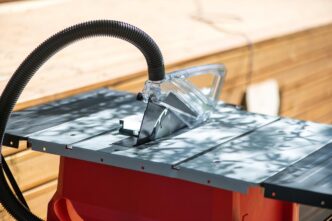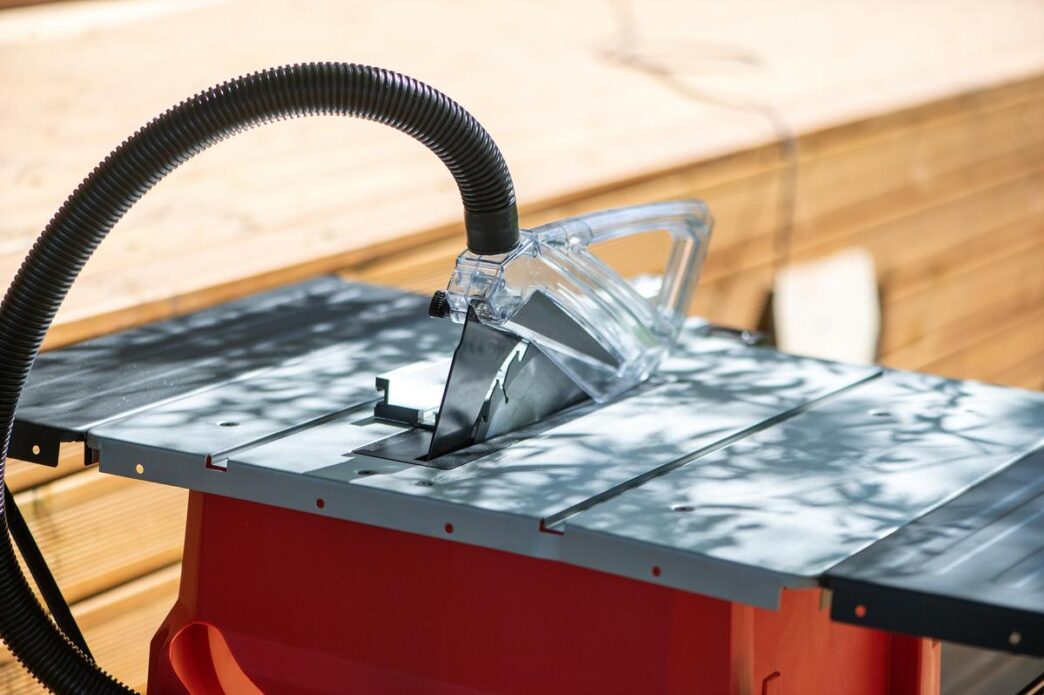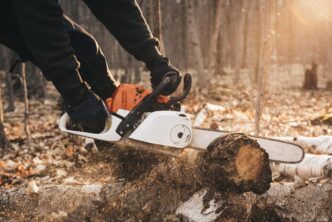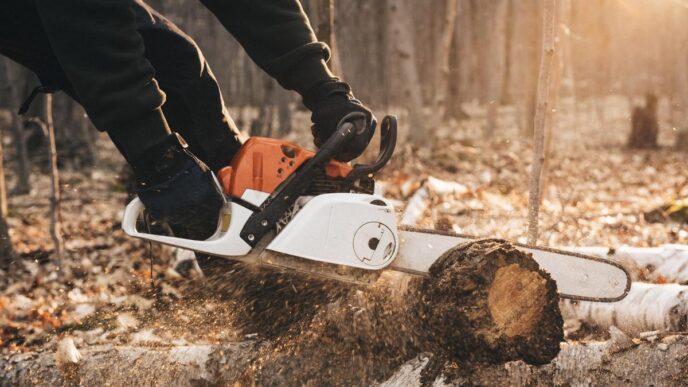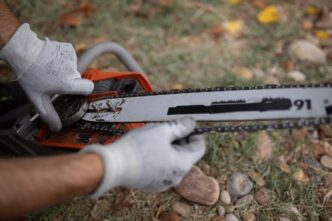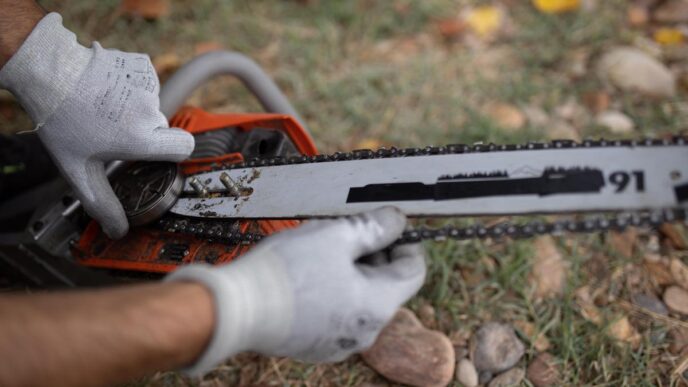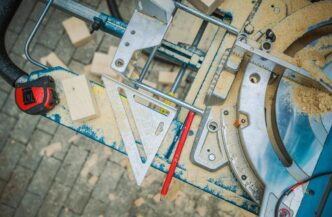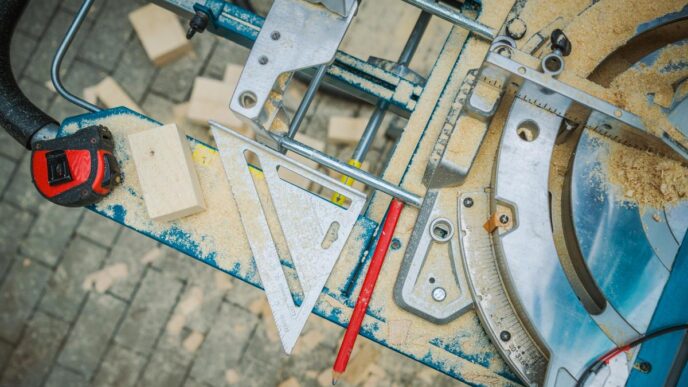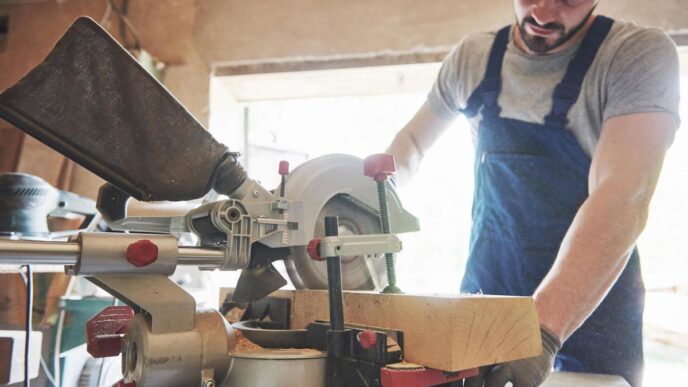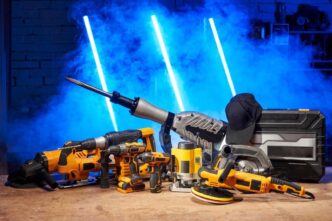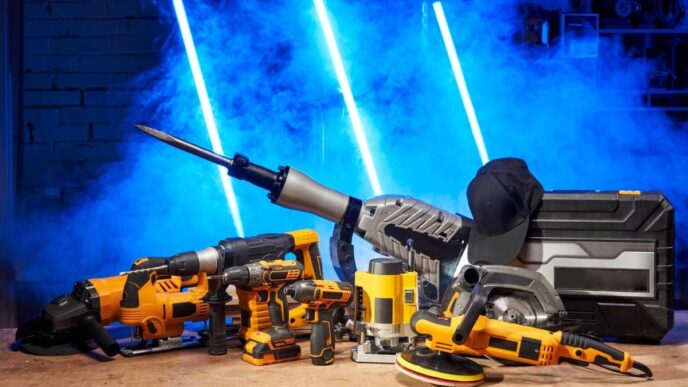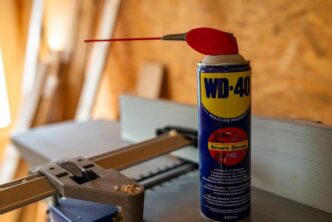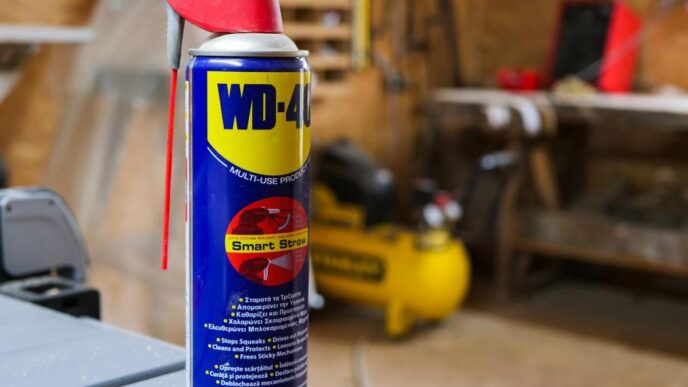Key Takeaways
- A table saw dust collection system captures dust during cutting using hoses, collectors, and fans connected to a dust hood or port.
- Importance: Dust collection improves air quality, protects lungs, reduces allergies, and keeps workspaces clean and efficient.
- Types: Single-stage, cyclone, and portable collectors are tailored to different needs, balancing space and cost.
- Optimizing: Seal table saw gaps, use bigger exhaust pipes, and adjust blade height to minimize dust spread.
- DIY Enhancements: Use PVC pipes, clamps, and silicone for cost-effective solutions, but ensure proper airflow.
- Accessories: Dust hoods, adapters, vacuum hoses, and cyclone separators enhance performance.
- Maintenance: Routine cleaning and inspection prevent blockages and maintain system efficiency.
- Portable Systems: Best for small workshops; less powerful but flexible and easy to move.
As woodworkers, we face the challenge of dust clouds. Table saw dust collection systems offer a solution. They keep our workspace clean and our lungs safe. How do these systems actually work? This blog post will explore dust collection setups, from basic mechanics to DIY enhancements. Discover how to optimize your system and enhance performance with accessories. Also, learn about maintenance tips to prolong system life. Dive in to transform your workshop today!
How Do Table Saw Dust Collection Systems Work?
What is a table saw dust collection system?
A table saw dust collection system removes dust and debris during cutting. It uses a mix of hoses, collectors, and fans to draw in dust right at the source. The system usually connects to a dust hood or a dust port on the table saw. This setup helps catch dust, making your workspace cleaner. Some table saws have built-in dust ports for easy connection.
Why is dust collection important in woodworking?
Dust collection keeps your workshop clean and safe. Breathing in sawdust can hurt your lungs. It reduces air quality and can cause allergies or asthma. By collecting dust, you protect your health and keep your work area neat. Clean areas also mean less time cleaning later. It makes your work more efficient and enjoyable.
Are there different types of dust collection setups for table saws?
Yes, there are several types of dust collection setups for table saws:
Single-Stage Collectors: These systems pull in air and dust in one step. They are easy and often cheaper.
Cyclone Collectors: These use two stages to separate dust from the air. Cyclone systems work better and take up less space. They cost about the same as multi-bag systems but are more efficient.
Portable Collectors: These small units can move around your shop. They are good for small spaces.
Each type works for different needs. Picking the right one depends on your space and budget. Choosing the right system improves your efficiency and air quality.
How Can You Improve Dust Collection on Your Table Saw?
What are the best practices for optimizing dust collection?
First, make sure to seal gaps in your table saw cabinet. This stops dust from escaping. To do this, use silicone or weather-stripping. Next, consider using at least a 5-inch exhaust pipe. Bigger pipes help move more dust. Think about adding rubber shields for moving parts. This reduces dust spread. Fabricate felt strips or use magnetic covers to close holes. Every bit counts in trapping dust.
How important is proper sealing in dust collection?
Proper sealing is crucial but needs balance. Tight seals make sure dust stays in the system. However, you need airflow to move the dust. If airtight, dust may not move to the collector. Some airflow helps guide all dust away. Thus, seal well but allow some air passage.
What role does blade height play in dust collection?
Blade height affects dust spread. Keep the blade low to just cut through the wood. This means less dust flies into the air. Adjusting the blade can greatly enhance collection. A lower blade keeps dust close to the saw, where it is most easily captured. Remember, blade height control is a simple yet powerful step.
What are Some Effective DIY Dust Collection Enhancements?
DIY dust collection enhancements improve dust control on your table saw. I’ve explored various DIY methods that woodworkers use to manage dust. Here’s how you can start crafting your own setup.
How can you build a DIY dust collection system?
To build a DIY system, begin by assessing your workspace needs. First, you need a basic dust hood that fits your table saw setup. Most setups use flexible hoses and clamps to connect the hood to a dust collector. I recommend using at least a 5-inch diameter exhaust pipe. This helps in drawing away more sawdust, especially if you own a 10″ Jet table saw.
What materials can be used for DIY dust collection solutions?
The materials are simple and often found in hardware stores. You can use PVC pipes, flexible hoses, and metallic clamps. I often use silicone to seal gaps around the saw cabinet. Some folks get creative and fabricate rubber shields for moving parts. Using felt strips or magnetic covers can also help to reduce dust escape.
Are DIY enhancements effective compared to commercial products?
DIY solutions have their pros and cons. Purchasing a commercial system may offer easier setup and possibly better performance. Yet, many woodworkers find DIY setups cost-effective and customizable. Adjusting components, like keeping the blade low, can significantly improve performance. Just remember, balancing airtight cabinet sealing with airflow is crucial. The positive side of DIY is that you can always upgrade as you go. For better performance in the long run, consider investing in a cyclone system like other enthusiasts suggest.
Which Dust Collection Accessories Enhance Performance?
What are the most recommended dust collection accessories?
When I choose dust collection fittings for my table saw, certain accessories stand out. I start with a quality dust hood or shroud. This attaches to the table saw, capturing dust right as it’s made. Next, I consider a good table saw adapter. It helps connect the saw to my dust collector hose. An adjustable vacuum hose is another key item. It gives me the freedom to reach different parts of the table. Finally, a cyclone separator is vital. It keeps bigger wood bits from ending up in the dust collector, boosting efficiency.
How do dust collection fittings impact performance?
The right fittings can change how well my dust collection performs. If I use the wrong size or type, air leaks will occur. This reduces how much dust I can capture. Tight-fitting connections from my saw to the dust collector improve suction power. Adjustable fittings let me adapt to various cut sizes. I use at least a 5-inch diameter pipe for excellent airflow and dust removal. Gaps in the setup can make dust go where it shouldn’t. Sealing these gaps with silicone is smart. It reduces dust escape and helps achieve cleaner cuts.
What are the benefits of using a dual-port dust collection system?
A dual-port system can double my dust collection power. By using two connection points, more dust is captured. This leads to cleaner air and less cleanup time. The two ports allow for efficient removal from both the top and bottom of my saw. I notice a large difference when cutting larger pieces of wood. Dual ports reduce the need for repeated cleanups. This makes my workshop not only cleaner but safer too. It’s similar to having two vacuums at work, making each cut much cleaner. I find it perfect for busy, active workshops like mine.
How Should Dust Collection Systems Be Maintained for Longevity?
Maintenance is key to a long life for dust systems. Let me explain the best practices.
What regular maintenance tasks should be done?
Daily cleaning keeps systems in top shape. Remove dust from filters. Empty dust bags or bins. Weekly, inspect hoses for cracks. Check connections for leaks. Make sure paths are clear for airflow. Monthly, tighten loose parts. Inspect where dust collects most.
How often should components be checked for wear and tear?
Inspect main components every three months. Look for worn belts or filters. Damaged parts can reduce efficiency. Six months is a good time frame for major components. Replace severely worn items. Keep spares on hand.
Check systems regularly for signs of trouble.
What troubleshooting steps can identify dust collection issues?
Listen for unusual sounds. They might signal blockages or loose parts. If you see dust escape, check for leaks or blockages. Low suction means it is time to clear out obstructions. Adjust the system to ensure all parts work smoothly. Test simple fixes first. Check each part to find the problem. Make sure all seals are tight.
Are Portable Dust Collection Solutions Viable for Small Workshops?
What are the Advantages of Portable Dust Collection Systems?
Portable systems help save space in tight workshops. They’re compact and easy to move. These systems suit small spaces well, because they can fit into corners or under tables. One drawback is they might not be as powerful as larger setups. Still, they offer flexibility, making them a great fit for tiny workshops.
How Do Portable and Stationary Systems Compare in Efficiency?
Portable systems often lack the power of their stationary cousins. This can mean less effective dust collection. Portables need more frequent emptying and might miss finer particles. However, they’re perfect when space and budget are limitations. If your workshop is small, the trade-off may be worth it.
Can Portable Systems Be Effectively Integrated with Various Table Saws?
Most portable systems connect easily to different table saws. They come with adapters for various saw models. Some saws might require specific fittings, but it’s usually simple. Portable options are flexible and widely compatible, making them suitable for many saw types.
For more on choosing the right portable system, you can find information here.
Conclusion
Table saw dust collection systems are crucial for a clean and safe workspace. We’ve explored the types, importance, and methods to improve these systems, as well as DIY tips and key accessories. Remember to maintain and occasionally check each component to ensure longevity. Whether you choose a portable or stationary setup, finding the right fit for your shop is key. Gather the right tools, follow safety practices, and tackle your projects with confidence. With this knowledge, you can make informed decisions to enhance your woodworking experience.
